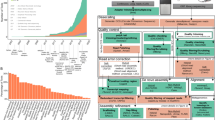Abstract
We present a technique (W-CGH) based on Comparative Genomic Hybridization (CGH), but using whole DNA probes, which permits the identification of chromosomal polymorphisms related to highly repetitive DNA sequences that exist between the two genomes compared. The procedure employs two differently colored whole DNA probes from two different individuals that are mixed and hybridized to metaphase chromosomes. The method provides a simple way to map whole genome differences for highly repetitive DNA sequences between two individuals, since it does not require chromosome-specific probes.
Similar content being viewed by others
References
Antin JH, Childs R, Filipovich A et al. (2001) Establishment of complete and mixed donor chimerism after allogenic lymphohematopoietic transplantation: recommendations for a workshop at the 2001 tandem meetings. BB&MM 7: 473–485.
Baldini A, Rocchi M, Archidiacono N, Miller OJ, Miller DA (1990) A human alpha satellite DNA subset specific for chromosome 12. Am J Hum Genet 46: 784–788.
Dewald GW, Schad CR, Christensen ER et al. (1993) Fluorescence in situ hybridization withXandYchromosome probes for cytogenetic studies in bone marrow cells after opposite sex transplantation. Bone Marrow Transplant 12: 149–154.
du Manoir, Speicher MR, Joos S et al. (1993) Detection of complete and partial gains and losses by comparative genomic hybridization. Hum Genet 90: 590–610.
Durnam DM, Anders KR, Fisher L, O'Quigley J, Bryant EM, Thomas ED (1989) Analysis of the origin of bone marrow cells in bone marrow transplant recipients using a Y-chromosome specific in situ hybridization assay. Blood 74: 2220–2226.
Edwards A, Hammond HA, Jin L, Caskey CT, Chakraborty R (1992) Genetic variation at five trimeric and tetrameric repeat loci in for human populations group. Genomics 12: 241–253.
Forozan F, Karhu R, Kononen J, Kallioniemi A, Kallioniemi OP (1997) Genome screening by comparative genomic hybridization. Trends Genet 13: 405–410.
Gusella JF, Wexler NS, Conneally PM (1983) A polymorphic DNA marker genetically linked to Huntington's disease. Nature 306: 234–238.
John B (1988) The biology of heterochromatin. In: Verma RS, ed. Heterochromatin, Molecular and Structural Aspects. Cambridge. Cambridge University Press, pp 1–147.
Kallioniemi A, Kallioniemi OP, Sudar D et al. (1992) Comparative genomic hybridization for molecular cytogenetic analysis of solid tumors. Science 258: 818–821.
Kallioniemi OP, Kallioniemi A, Piper J et al. (1994) Optimizing comparative genomic hybridization for analysis of DNA sequence copy number changes in solid tumors. Genes Chromosomes Cancer 10: 231–243
Lee C, Wevrick R, Fisher RB, Ferguson-Smith MA, Lin CC (1997) Human centromeric DNAs. Hum Genet 100: 291–304.
Lichter P, Bentz M, Joos S (1995) Detections of chromosomal aberrations by means of molecular cytogenetic painting of chromosomes and chromosomal subregions and comparative genomic hybridization. Meth Enzymol 254: 334–359.
Lichter P, Joos S, Bentz M, Lampel S (2000) Comparative genomic hybridization: uses and limitations. Semin Hematol 37: 348–357.
Nebert DW (1997) Polymorphisms in drug-metabolizing enzymes: what is their clinical relevance and why do they exist?. Am J Hum Genet 60: 265–271.
Polymeropoulos MH, Xiao H, Rath DS, Merril CR (1991) Tetranucleotide repeat polymorphism at the human coagulation factor XIII A subunit gene (F13A1). Nucleic Acids Res 19: 4036.
Speicher MR, du Manoir S, Schröck E et al. (1993) Molecular cytogenetic analysis of formalin-fixed, paraffin embedded solid tumors by comparative genomic hybridization after universal DNA-amplification. Hum Mol Genet 2: 1907–1914.
Sumner AT (1972) A simple technique for demonstrating centromeric heterochromatin. Exp Cell Res 75: 304–306.
Verma RS (1988) Heteromorphisms of heterochromatin. In: Verma RS, ed. Heterochromatin, Molecular and Structural Aspects. Cambridge: Cambridge University Press, pp 276–292.
Waye JS, Durfy SJ, Pinkel D et al. (1987) Chromosome-specific alpha satellite DNA from human chromosme 1: hierarchical structure and genomic organization of a polymorphic domain spanning several hundred kilobase pairs of centromeric DNA. Genomics 1: 43–51.
Waye JS, Willard HF (1989) Human b satellite DNA: genomic organization and sequence definition of a class of highly repetitive DNA. Proc Natl Acad Sci USA 86: 6250–6254.
Author information
Authors and Affiliations
Corresponding author
Rights and permissions
About this article
Cite this article
Pita, M., Luis Fernández, J. & Gosálvez, J. Whole-comparative genomic hybridization (W-CGH): 1. The quick overview of repetitive DNA sequences on a genome. Chromosome Res 11, 673–679 (2003). https://doi.org/10.1023/A:1025937726614
Issue Date:
DOI: https://doi.org/10.1023/A:1025937726614




